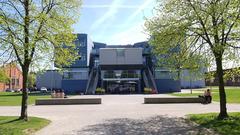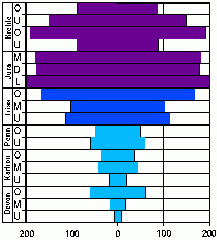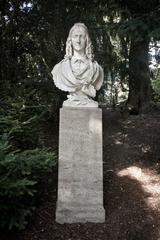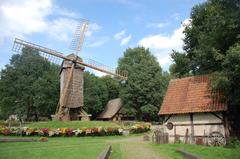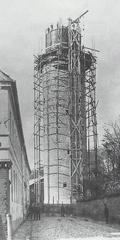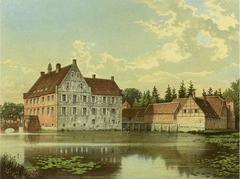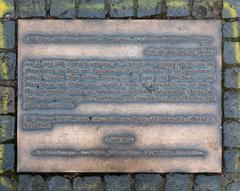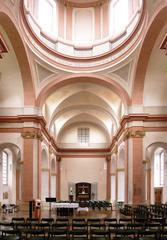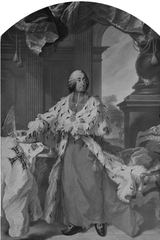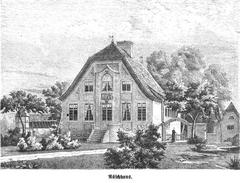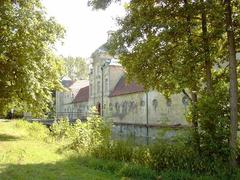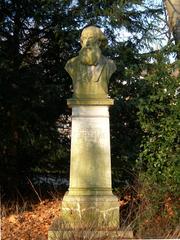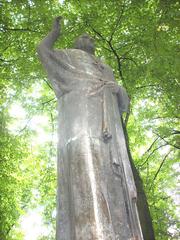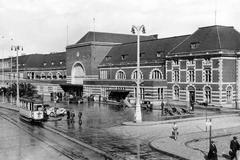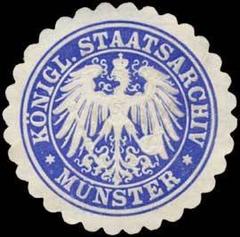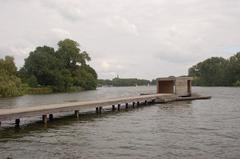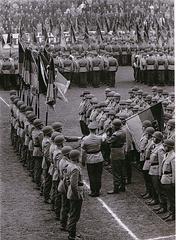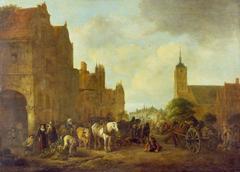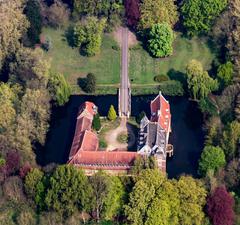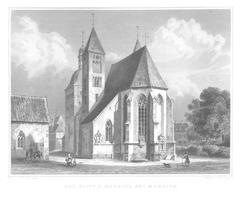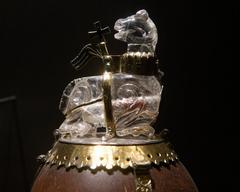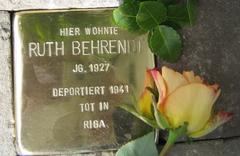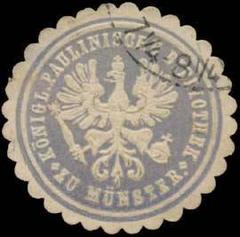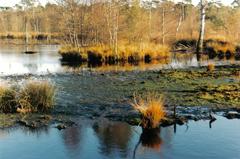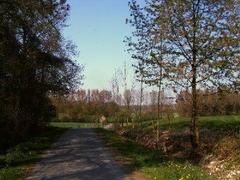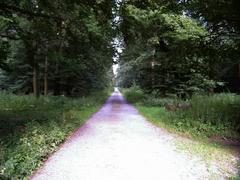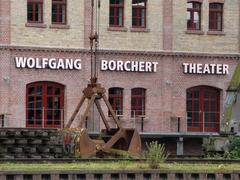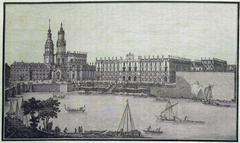Harbor Crane (Hafenkran) Münster, Germany: Visiting Hours, Tickets, and Travel Guide
Date: 14/06/2025
Introduction
The Harbor Crane (Hafenkran) in Münster stands as a striking testament to the city’s industrial past and its evolution into a thriving cultural destination. Erected in the early 20th century during the inauguration of Münster’s harbor in 1899, this iconic crane facilitated the city’s rise as a trade and logistics hub. Its original function—loading and unloading goods such as coal, grain, and building materials—underscored Münster’s strategic significance, especially after the harbor’s connection to the Dortmund-Ems Canal, which linked the city to the North Sea and the Ruhr industrial region (Wikipedia: History of Münster; Münsterland Tourism).
Today, the Harbor Crane is a meticulously preserved open-air monument, symbolizing both technological progress and the enduring spirit of Münster. Its robust steel structure and rotating jib exemplify early 20th-century engineering, while its presence in the revitalized harbor district reflects Münster’s commitment to blending industrial heritage with contemporary urban life. Open to visitors year-round and free of charge, it is both a historical landmark and a focal point for cultural engagement, community events, and guided tours (Europe for Visitors; Münster Marketing).
Whether you are a history enthusiast, an admirer of industrial architecture, or a cultural traveler, this comprehensive guide covers everything you need to know about the Harbor Crane in Münster—from its origins and symbolism to practical visitor information and local attractions.
Table of Contents
- Historical Context and Development
- Architectural and Technological Significance
- Symbolism and Cultural Importance
- Visiting Information
- Practical Tips for Visitors
- Sustainability and Urban Regeneration
- Frequently Asked Questions (FAQ)
- Summary Table: Key Facts
- Additional Resources and References
Historical Context and Development
Medieval Trade and Hanseatic Influence
Münster’s geographic position in North Rhine-Westphalia made it a prominent medieval trading center, particularly as a member of the Hanseatic League. By the 16th century, the city thrived on commerce, necessitating the construction of harbor infrastructure and the early use of cranes for cargo handling (Wikipedia: History of Münster).
Industrialization and Harbor Expansion
The most transformative period for Münster’s harbor began in 1899 with its connection to the Dortmund-Ems Canal. This vital waterway linked Münster directly to the North Sea and Ruhr region, catalyzing industrial growth and establishing the city as a major center for warehousing, trade, and media (Wikipedia: History of Münster).
Evolution of Crane Technology
Early European cranes, dating back to the Middle Ages, were simple wooden devices powered by humans or animals. The Industrial Revolution introduced steam-powered, and later electrically powered, steel cranes, greatly improving efficiency and lifting capacity (Acorn Industrial: The History of the Crane; Complete Lifting Services: Evolution of Cranes).
The Harbor Crane in Münster, with its steel framework, rotating jib, and substantial lifting power, is a quintessential example of these industrial advancements. Today, it is preserved as a monument to the city’s industrial transformation (Münsterland Tourism; Europe for Visitors).
Architectural and Technological Significance
The Harbor Crane’s design reflects early 20th-century German engineering, constructed from riveted steel and equipped with mechanical winches that were initially steam-driven and later electrified (Mordor Intelligence: Crane Market in Germany). Its functional and aesthetic qualities—robustness, efficiency, and safety—made it a cornerstone of harbor logistics, enabling the movement of heavy goods with precision.
Today, the crane is an emblem of industrial heritage, seamlessly integrated into Münster’s modern harbor district, which now features a blend of historic warehouses repurposed as restaurants, galleries, and cultural venues (Münsterland Tourism: The Port in Münster).
Symbolism and Cultural Importance
Local and Global Symbolism
Cranes—both mechanical and avian—are potent symbols of longevity, wisdom, and transformation. In Münster, the Harbor Crane represents endurance and adaptability, mirroring the city’s journey from a medieval stronghold to a forward-thinking urban center (Symbol Sage: Crane Symbolism; Rigid Machinery).
Globally, cranes are revered for their associations with good fortune, vigilance, and renewal. The Harbor Crane, therefore, serves not just as a relic but as a totem of community identity and progress.
Urban Regeneration and Public Art
Münster’s harbor district exemplifies successful urban regeneration. The preservation of the Harbor Crane and surrounding industrial structures has fostered a unique environment where history and innovation coexist, hosting public art, concerts, and festivals (Münsterland Tourism: The Port in Münster).
Visiting Information
Location and Access
The Harbor Crane is located on the northern quay of Münster’s harbor district, southeast of the historic city center. It is easily accessible by foot, bicycle, or public transport (bus lines 5 and 6). The area is well-signposted, and parking is available, though limited during peak times (Münster Marketing).
Visiting Hours and Tickets
- Crane Access: Open-air monument, accessible 24/7, year-round.
- Admission: Free. No tickets are required.
- Nearby Venues: Restaurants, galleries, and visitor centers typically open 10:00 AM–8:00 PM.
Tours and Events
Guided tours of the harbor district, including detailed history about the crane, are offered seasonally (April–October, weekends). Tours usually cost around €8 per person and can be booked via the Münster Tourist Office. The harbor also hosts open-air concerts, art exhibitions, and weekly markets (Münsterland Tourism: Events in Münster).
Nearby Amenities and Attractions
- Dining: Numerous cafés and restaurants with waterfront terraces.
- Restrooms: Available near major venues.
- Bike Rentals: Several stations reflect Münster’s “bicycle city” status.
- Cultural Venues: The Kunsthalle Münster gallery, public art installations, and event spaces (Münsterland.com).
Practical Tips for Visitors
Accessibility and Safety
- Physical Access: The harbor promenade is paved and wheelchair accessible.
- Water Safety: The harbor basin is unfenced; supervise children and avoid climbing on structures.
- Bicycles: Watch for cyclists on shared paths.
Best Times to Visit
- May–September is ideal, especially June, with pleasant weather and lively events (Weather and Climate; Kimkim: Germany in June).
- Evenings offer beautiful lighting for photography and a vibrant atmosphere.
Travel Etiquette
- Use public transport or bicycles for eco-friendly travel.
- Keep noise levels low in residential areas and greet locals with “Guten Tag.”
Sustainability and Urban Regeneration
Münster Harbor is a model for sustainable urban redevelopment. A state-of-the-art heat pump at the port’s power plant provides climate-neutral heating for hundreds of households, significantly reducing CO₂ emissions and supporting Münster’s green initiatives (Grüner Strom Label).
Frequently Asked Questions (FAQ)
Q: What are the Harbor Crane visiting hours?
A: The crane is outdoors and accessible 24/7, free of charge.
Q: Are guided tours available?
A: Yes, seasonal tours are offered by the Münster Tourist Office, usually from April to October.
Q: Is the area accessible for people with disabilities?
A: Yes, the promenade is wheelchair accessible and equipped with multilingual information panels.
Q: Can I take photographs at the Harbor Crane?
A: Absolutely! The crane and harbor district are popular for photography.
Q: Are there tickets required for the crane or harbor area?
A: No tickets are needed for outdoor areas; fees may apply for museum entries or guided tours.
Summary Table: Key Facts
| Feature | Details |
|---|---|
| Location | Münster Harbor District, northern quay |
| Access | Open 24/7, free admission |
| Best Time to Visit | May–September; June is ideal |
| Accessibility | Wheelchair accessible, paved promenade |
| Guided Tours | Seasonally available; check with tourist office |
| Nearby Amenities | Dining, public restrooms, bike rentals, galleries |
| Event Information | Münster Event Calendar |
| Tourist Office | Heinrich-Brüning-Strasse 9, city center |
Additional Resources
- Münsterland Official Tourism
- Germany Travel - Münster
- Grüner Strom Label - Münster Heat Pump Project
- Explorial - Münster Hidden Gems
- Europe for Visitors: Münster Travel Guide
- Münster Marketing: Event Calendar
Conclusion
The Harbor Crane in Münster is more than just an industrial relic; it is a living symbol of the city’s resilience, adaptability, and progressive spirit. Its preserved structure and commanding presence anchor Münster’s past to its creative present, while the surrounding harbor district exemplifies how urban regeneration can celebrate heritage and foster innovation. With unrestricted access, vibrant cultural programming, and a commitment to sustainability, the Harbor Crane is an essential stop for any visitor seeking to experience Münster’s unique blend of history and modernity.
Plan your visit to coincide with a harbor event or sunset stroll, and explore nearby attractions to make the most of your Münster experience. For updated information on tours, events, and insider tips, consult the Münster Tourist Office, download the Audiala app, and follow local tourism channels.
References
- This article draws on information from the following sources:
- Wikipedia: History of Münster
- Münsterland Tourism
- Acorn Industrial: The History of the Crane
- Complete Lifting Services: Evolution of Cranes
- Rigid Machinery: Cultural Significance of Cranes
- Mordor Intelligence: Crane Market in Germany
- Symbol Sage: Crane Symbolism
- Münster Marketing: Event Calendar
- Europe for Visitors: Münster Travel Guide
- Grüner Strom Label: Münster Heat Pump Project
- Germany Travel - Münster
- Explorial - Münster Hidden Gems
